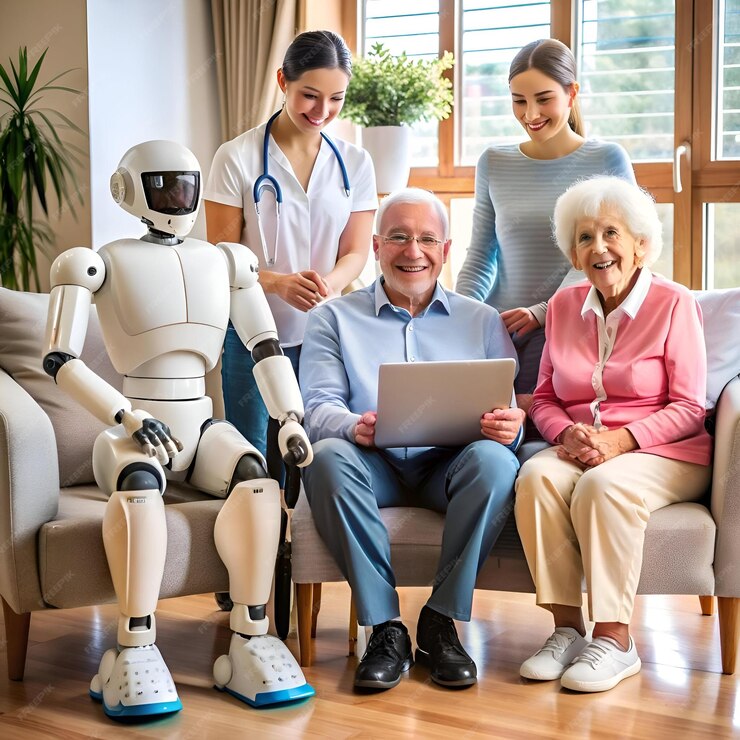As the world of senior care evolves, one of the most exciting developments is the growing role of senior living technology. AI and automation are no longer distant dreams; they are transforming how seniors live and how caregivers provide support. With an aging population and increasing demands on care providers, the integration of technology is changing the game for both residents and the senior living industry. Let’s explore how these updated technologies are shaping the future of senior care and making it better than ever.
1. AI-Powered Health Monitoring
One of the most significant ways AI is making a difference in senior living technology is through health monitoring. Seniors often require close observation due to chronic conditions or the potential for falls. With AI, smart devices can continuously monitor vital signs like heart rate, blood pressure, and movement patterns. If something seems off, the system can alert caregivers or medical professionals in real time.
These AI-driven systems help ensure that seniors are safe even when they are alone, reducing the need for constant physical supervision. This not only gives seniors more independence but also provides peace of mind for families and caregivers. With health monitoring, any health issue can be detected early, leading to quicker interventions.
2. Automated Reminders and Assistance
Forgetfulness is a common issue as we age, and this is where AI-powered reminders shine. From reminding seniors to take their medications to ensure they attend doctor’s appointments, automation can significantly improve day-to-day management. Voice-activated assistants like Google Home can be programmed to offer gentle reminders, help with scheduling, and even control smart appliances in the home.
These systems are especially beneficial for seniors with cognitive impairments or those who struggle with routine tasks. This level of automation within senior living technology supports independence while reducing the workload of caregivers, creating a balanced environment for all.
3. Smart Homes and Enhanced Security
Smart home technologies, which are a growing part of senior living technology, are revolutionizing senior care by offering enhanced security and convenience. Automated lighting, temperature control, and even smart locks can be controlled through voice commands or smartphone apps, making homes more accessible and safe for seniors.
These smart home systems can detect unusual activity, such as a front door being left open or a lack of movement within a certain period. By integrating with home security systems, caregivers can remotely check on seniors, ensuring they are safe without needing to be physically present.
4. Virtual Companionship and Social Interaction
Loneliness is a major issue for many older adults, particularly those living alone. AI and automation are stepping in with virtual companionship. Devices like AI-powered robots or even virtual pets provide seniors with interactive social engagement. These digital companions can engage in conversations, play games, and even help seniors maintain social connections with family members through video calls.
While AI companionship can never replace human relationships, it can certainly help combat loneliness and improve mental well-being.
5. Streamlining Caregiver Responsibilities
For caregivers, the integration of AI in senior living technology means fewer manual tasks and more time for personal, hands-on care. Automating routine tasks such as tracking medication schedules, logging health data, and monitoring vitals allows caregivers to focus on what matters most—connecting with and caring for their patients.
AI can also help predict when a senior’s condition might worsen based on health data trends, allowing for more proactive care. By lightening the load of administrative work, caregivers can be more present, less stressed, and ultimately provide better care.
6. Predictive Analytics for Better Care Planning
One of the key benefits of AI in senior living technology is its ability to use predictive analytics. By analyzing large amounts of health data, AI can help predict health outcomes and risks, enabling caregivers to make more informed decisions. Whether it’s flagging a potential fall risk or detecting early signs of a chronic condition, predictive analytics make senior care more preventive and less reactive. This helps caregivers and families stay ahead of potential health crises, reducing hospital visits and ensuring a higher quality of life for seniors.
Conclusion: The Future of Senior Living is Here
AI and automation in senior living technology are more than just buzzwords—they are actively improving the lives of seniors and their caregivers. From health monitoring to smart homes and virtual companionship, these technologies provide seniors with greater independence, safety, and comfort. At the same time, caregivers are better equipped to manage their responsibilities efficiently.
As the senior living technology field continues to evolve, the future looks bright for senior care. With the right integration of AI and automation, we can ensure that seniors live healthier, happier, and more independent lives while reducing the challenges faced by caregivers. The future of senior living is smarter—and that’s something we can all look forward to.


